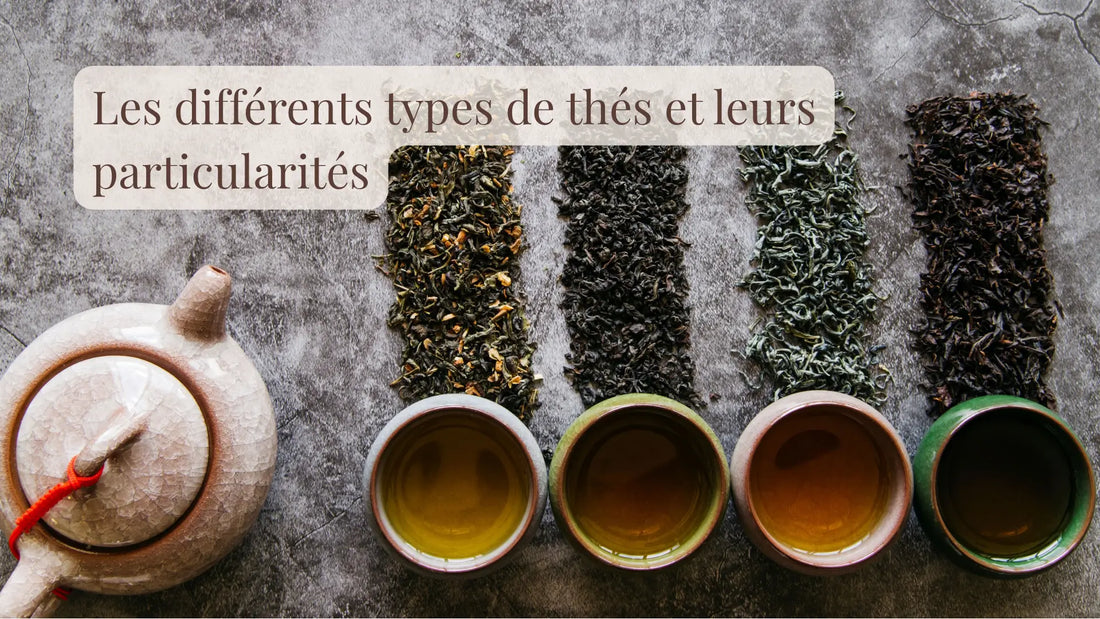
The different types of teas and their particularities
share
Tea is much more than just a hot beverage. It's an ancient elixir, rich in history and flavors, and boasting a fascinating diversity. In this article, we invite you to delve into the captivating world of different tea varieties, exploring their origins, unique characteristics, and the pleasures they provide.
Green tea: a delicacy from the Far East
Green teas are among the oldest and most iconic varieties in the tea world. Native to Asia, these natural treasures are distinguished by their freshness and finesse. Each growing region has developed its own cultivation and processing techniques, giving rise to a palette of fascinating flavors and aromas.
Japanese Sencha (煎茶) , for example, is characterized by its vegetal notes and silky texture, while Chinese Longjing (龙井茶) surprises with its roasted notes and delicate bitterness. Gyokuro (玉露) , on the other hand, is a shade-grown Japanese green tea, offering a taste experience of rare complexity.
These green teas are often praised for their health benefits, thanks to their high antioxidant and vitamin content. They provide a gentle and soothing source of energy, ideal for recharging throughout the day.
Black tea: richness of flavors
While green teas are the stars of the Far East, black teas reign supreme in other regions of the globe. Produced through a more advanced oxidation process, these teas offer a more intense and deeper palette of flavors.
From Indian Darjeeling , with its floral and fruity notes, to Chinese Lapsang Souchong (正山小种), smoked over pine wood, each region has developed its own specialties. Keemun , or Qimen (祁門紅茶), also from China, is distinguished by its sweetness and roundness in the mouth, while Assam , grown in the northeast of India, surprises with its power and richness.
These black teas are often prized for their comforting and stimulating properties, due to their higher caffeine content. They are an ideal companion for relaxing or socializing.
White tea: ancestral purity
White teas are the rarest and most precious in the tea world. Derived from the buds and young leaves of the plant, they undergo minimal processing, thus preserving their freshness and purity.
Bai Mudan , or Pai Mu Tan (白牡丹), from China, is distinguished by its floral and vegetal notes, while Bai Hao Yinzhen (白毫银针) , also Chinese, surprises with its sweetness and finesse. These white teas are often appreciated for their health benefits, thanks to their high antioxidant content.
Oolong tea: perfect balance
Oolong teas are a fascinating bridge between green and black teas. Produced through a partial oxidation process, they offer a unique palette of flavors and textures.
Tie Guan Yin , from China, is characterized by its floral and fruity notes, while Da Hong Pao , also from China, surprises with its richness and complexity. These oolong teas are often appreciated for their ability to comfort and stimulate, while preserving a certain freshness.
The subtleties of tea tasting
Each tea variety requires careful attention. Water temperature, steeping time, and the quantity of leaves used are crucial parameters for revealing the full subtlety and complexity of flavors. Oversteeped tea can become bitter and astringent, while water that's too hot risks altering its delicate aromas. The art is finding the right balance to allow the full richness of these natural treasures to shine through.
Endless exploration
The world of tea is a treasure trove, rich in history, flavors, and benefits. From the Far East to India and China, each region has developed its own specialties, offering a fascinating diversity to explore. Whether you're a fan of green teas, black teas, white teas, or oolong teas, there will always be new discoveries to be made, new flavors to be savored, and new experiences to be had. So, don't hesitate to embark on this exciting exploration that is the world of tea.
Photo credit: Freepik




